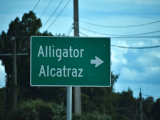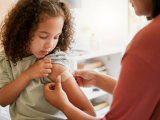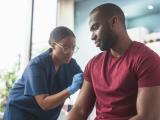Sep 11, 2009 (CIDRAP News) – US health officials offered more evidence today that a single dose of pandemic H1N1 influenza vaccines may be enough to protect adults, saying preliminary findings in government-sponsored trials reinforce early results from company trials announced yesterday.
In the government trials, large majorities of nonelderly adults had a "robust" immune response just 8 to 10 days after receiving H1N1 vaccines made by Sanofi Pasteur and CSL Ltd, said Dr. Anthony Fauci, director of the National Institute of Allergy and Infectious Diseases (NIAID), at a news briefing this afternoon.
Elderly people had somewhat lower response rates of 56% and 60%, but that is in line with older people's response to seasonal flu vaccines, Fauci reported. The two vaccines were tested without adjuvants and at the same doses used in seasonal flu vaccines: 15 micrograms (mcg) of antigen.
Since the H1N1 vaccine is new, most experts had expected it would take two doses to protect people. Evidence that one dose is effective means more people can be protected with a given amount of vaccine, and a single-dose regimen also means faster protection, since 2 doses have to be given at least 3 weeks apart.
However, officials acknowledged today that, with the virus spreading rapidly in several states, the vaccine may come too late for some people. Doses are expected to become available in quantity starting in mid October, but the Centers for Disease Control and Prevention (CDC) said the virus is currently widespread in 11 states—five more than a week ago.
Also, it remains likely that young children, who have little or no previous exposure to flu or flu vaccines, will need two doses of H1N1 vaccine. The first results of trials in children are expected in about 2 weeks, Fauci said.
Yesterday, CSL and Novartis reported that large majorities of adults had a strong immune response to single doses of the companies' vaccines after 21 days. The Novartis vaccine contained an adjuvant (MF59), while the CSL product did not. US officials hope to be able to use vaccines without adjuvants, because adjuvanted flu vaccines have not been used in the United States before and doing so would raise regulatory issues. (Novartis is testing its vaccine both with and without its adjuvant.)
The US government has ordered H1N1 vaccines from CSL, Novartis, Sanofi, GlaxoSmithKline, and Medimmune. Federal official have said the biggest share, about 45% of the supply, is expected from Novartis.
At today's press conference, Fauci said, "I'm very pleased today to be able to tell you that the initial results from the NIH [National Institutes of Health]-sponsored trials corroborate and reinforce the findings from the companies." The trial showed that "a single 15-mcg dose of unadjuvanted vaccine is well tolerated and induced an immune response in healthy adults that is generally predictive of protection."
Researchers took blood samples 8 to 10 days after vaccination to test immune responses. They found that the Sanofi vaccine induced a "robust" immune response in 96% of adults aged 18 to 64 and in 56% of adults 65 and older, the NIAID said in a news release.
Similarly, a single 15-mcg dose of the CSL vaccine generated a robust response in 80% of adults between 18 and 64 and in 60% of older adults, the agency said.
The slight differences between the two vaccines may be due to technical differences in the preliminary measurement of the amounts of antigen in the doses used and the lmited number of samples studied so far, the statement added.
On the safety side, "There have not been any significant adverse events whatsoever," said Fauci. The most common side effects have been swelling and redness at the injection site, not unusual with flu and other shots.
The lower immune response rate in older people was not surprising, Fauci said. "The results we're seeing are essentially right on the money of what we see with seasonal influenza vaccine. Elderly individuals generally have less of a response," he said. Older people are not a priority group for H1N1vaccination, since they appear to have some protection against the virus, apparently because of past virus and vaccine exposures.
Health and Human Services Secretary Kathleen Sebelius called the results very encouraging. Based on the expectation of a two-dose regimen, "we thought people wouldn't be fully immunized until after Thanksgiving," but the trial results suggest that the first vaccine recipients will have immunity weeks earlier, she said.
A leading flu vaccine expert, Dr. Gregory A. Poland of the Mayo Clinic in Rochester, Minn., said he was pleasantly surprised by the findings announced yesterday and today.
"We've all made the assumption based on past history that with a novel antigen it would take two doses" to generate immunity, he told CIDRAP News. "So maybe H1N1 isn't as novel as H5N1, where clearly two doses were necessary to reach protective levels of immunity in only half the population."
Referring to the CSL vaccine, he added, "The important news is that this was without adjuvant. I think most everybody thought we're talking two doses, or one dose with adjuvant. This is somewhat preliminary, there were only 240 subjects . . . but this is very good preliminary news."
"This will make a major difference in our ability to respond to the pandemic, because you can immunize so many people so much more quickly," Poland added. "This means a 2-week time frame before you have immunity versus a 5-week time frame."
At the same time, he said it's highly likely that young children will need two doses of the vaccine. The standard advice is that children younger than 9 need two doses of seasonal flu vaccine if they've never been vaccinated before, he noted.
"I suspect what'll happen [with the H1N1 trial results] is that as we work our way down the age range, there'll be some age where you'll need two doses," Poland said. "The question is, 'When is one enough?'"
Federal officials have said they expect that the first 45 million to 55 million doses of vaccine will start flowing to vaccinators in mid October. At today's briefing, Dr. Jesse Goodman, director of the Food and Drug Administration (FDA) Center for Biologics Evaluation and Research, said, "October 15 continues to look like a reasonable target for a substantial amount of vaccine. We're certainly doing what we can to make some available sooner."
He also expressed satisfaction that 15 mcg seems to be an adequate dose, since federal officials advised the vaccine manufacturers a few weeks ago to proceed on that assumption.
But in response to a question at today's briefing, Fauci acknowledged that with the virus spreading rapidly, the vaccine may arrive too late for some people. Given that the novel virus just emerged in April, "the amount of time to make the vaccine was quite good, but there could be peaks [in cases] before people get vaccinated," he said.
Dr. Anne Schuchat, director of the CDC's National Center for Immunization and Respiratory Diseases, said the timing of H1N1 outbreaks will vary in communities across the country, adding, "We do believe that many prevention opportunities will be possible with this vaccine."
Poland, commenting on the timing question, said, "We're already seeing in colleges that as kids get back and are in large congregated groups, boom, they have flu in there. . . . So clearly it'll be too late for them. But the sooner we get the vaccine the better," and a one-dose regimen will mean people will be protected weeks earlier.
See also:
Sep 10 CIDRAP News story "Early results suggest 1 dose of H1N1 vaccine may be protective"
Sep 11 NIAID news release


















